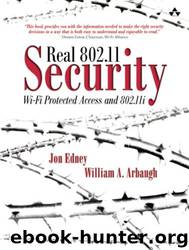Addison Wesley : Real 802.11 Security: Wi-Fi Protected Access and 802.11i by By Jon Edney William A. Arbaugh

Author:By Jon Edney, William A. Arbaugh [By Jon Edney, William A. Arbaugh]
Language: rus
Format: epub
ISBN: 0321136209
Publisher: Addison Wesley
Published: 0101-01-01T00:00:00+00:00
Temporary session keys
Centralized key management
Protected EAP Protocol (PEAP)
PEAP, as the name suggests, provides a way to do EAP negotiation safe from prying eyes. The original motivation was to make password-based client security safe from offline dictionary attack. To achieve this, the EAP session is completely hidden from attackers. It was hard to decide whether PEAP should be in Chapter 8 in the discussion of access control or here, in the coverage of upper-layer authentication. PEAP is a sort of welding together of EAP and TLS in an attempt to maintain the flexibility of EAP while overcoming its lack of inherent security protection.
First, let's consider the security weaknesses of EAP. EAP is like a good sandwich: meaty center surrounded by two slices of thin bread (apologies to vegetarians). The meaty center is the authentication exchange between the client and the server. If a method like TLS is used, the security credentials of this part are good. The thin slices of bread are the parts of EAP that are common to all methodsthe EAP-Identity phase and the EAP-Success or EAP-Fail messages at the end. This is where the security weaknesses occur:
Because the EAP-Identity message is unprotected, it can be snooped, allowing an enemy to learn the identity of the user that is attempting to connect.
Download
This site does not store any files on its server. We only index and link to content provided by other sites. Please contact the content providers to delete copyright contents if any and email us, we'll remove relevant links or contents immediately.
Deep Learning with Python by François Chollet(15959)
The Mikado Method by Ola Ellnestam Daniel Brolund(13225)
Hello! Python by Anthony Briggs(13052)
OCA Java SE 8 Programmer I Certification Guide by Mala Gupta(12234)
Dependency Injection in .NET by Mark Seemann(12080)
Algorithms of the Intelligent Web by Haralambos Marmanis;Dmitry Babenko(10854)
The Well-Grounded Java Developer by Benjamin J. Evans Martijn Verburg(10674)
A Developer's Guide to Building Resilient Cloud Applications with Azure by Hamida Rebai Trabelsi(10538)
Grails in Action by Glen Smith Peter Ledbrook(10149)
Secrets of the JavaScript Ninja by John Resig Bear Bibeault(10043)
Sass and Compass in Action by Wynn Netherland Nathan Weizenbaum Chris Eppstein Brandon Mathis(9487)
Hit Refresh by Satya Nadella(9040)
Kotlin in Action by Dmitry Jemerov(8761)
Test-Driven iOS Development with Swift 4 by Dominik Hauser(8651)
The Kubernetes Operator Framework Book by Michael Dame(8485)
Exploring Deepfakes by Bryan Lyon and Matt Tora(8307)
Robo-Advisor with Python by Aki Ranin(8261)
Practical Computer Architecture with Python and ARM by Alan Clements(8232)
Implementing Enterprise Observability for Success by Manisha Agrawal and Karun Krishnannair(8202)
